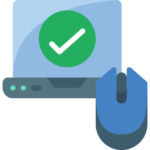Welcome!

Director & Lead Tutor
Welcome to the first section of your iGCSE Computer Science course. Before we start, I’d like to introduce you to how to use the course materials and navigate around.
Each lesson in this course is divided into two sections: the lesson content and a recorded live lesson.
The digital notes are there to help you to put things into your own words. You can access these on the Digital Notes tab, or as a PDF in the “Exercise Files” under the lesson video.

Click on the three bars at the top of your notes to expand the menu & use the dots to navigate through your notes.
Although your notes will autosave, I recommend that you download/export a copy at the end of each session.
The content on this page is divided into sections which you can work through by using the dots at the top of the screen, or the arrows to the right. If you need help as you work through each lesson, click on the blue question mark at the bottom right of the screen to send me a question.
An audio version of each section is available at the top of the screen.
Holly Billinghurst
Course Leader
Theory

Each week, we’ll be working through topics from both exam papers to give you enough time to practice both. Most of the theory topics are covered in paper 1 which is a written paper that includes multiple choice, short, and long answer questions.
Over the past few years, the questions in this paper have included short essays and more long answer questions that encourage you to apply your knowledge rather than just remember facts.
Although it’s not the first topic in the specification, it’s a good idea to start with the Data Representation lessons for theory as these appear in almost every other topic. The most important topics in year 1 will be binary, hexadecimal, and images.
Over the next few weeks, we’ll be working through the more advanced sections on adding & shifting binary numbers alongside the calculating bitmap image size questions.
Programming
Programming requires regular practice, so although there are only a few lessons for the techniques we’ll regularly cover this as part of your weekly practice questions.
You’ll be starting off with the Sequence & Selection lessons soon – don’t worry that it feels like a lot at first, if you get stuck, you can always use the help button at the bottom of the screen to send me a message.
To make sure that you’re prepared to start coding over the next few weeks, I’d recommend that you create a free account on Repl.it as this will allow you to use the practice questions and challenges throughout the course.
